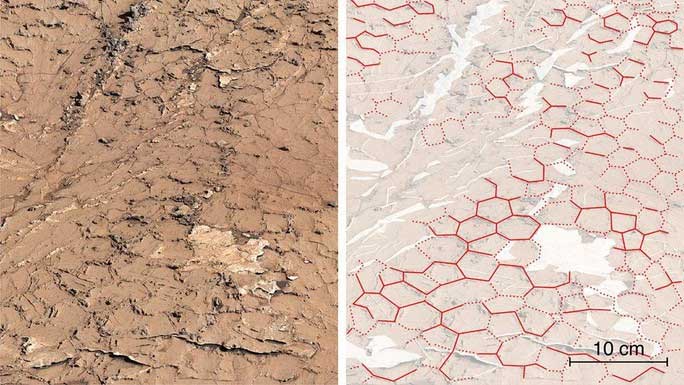The unusual structures resembling honeycombs discovered by the Curiosity rover represent a crucial link in NASA’s efforts to demonstrate that the Red Planet may harbor life.
A study recently published in the journal Nature, led by the National Center for Scientific Research (CNRS) in the United States, indicates that the extraordinary images sent back to Earth by NASA’s Curiosity rover provide the most vivid hints of life.
“This is the first tangible evidence showing that the ancient climate of Mars experienced regular wet-dry cycles similar to Earth, which is necessary for molecular evolution that could lead to life,” stated Dr. William Rapin, a planetary scientist from CNRS.

The unusual structures found by Curiosity on Mars are indeed cracks similar to those in Earth’s lake beds during drought – (Photo: NASA).
This means that this location is not only a potential refuge for life but also one of the possible sites where life could have originated on Mars—one of NASA’s most carefully monitored targets in the search for extraterrestrial life.
According to NASA, the honeycomb shape represents a patchwork of ancient mud cracks found on the 5km high Sharp Mountain within Gale Crater, a massive impact crater on the Red Planet.
The “honeycombs” are estimated to be between 3.8 to 3.6 billion years old, corresponding to a period when previous NASA studies indicated that Mars was abundant in water similar to Earth.
The area containing the “honeycombs” is located just above a clay-rich zone, which is the bed of an ancient lake, and below a sulfate-rich area left behind after the water had dried up.
The “honeycombs” also show signs of sulfates, providing evidence that the area has undergone repeated wet and dry conditions. This indicates that a vast region once served as a wetland or an expansive lake during humid periods, only to shrink during dry spells, just as occurs on Earth today.
This area has also shown signs of organic compounds, which could potentially be remnants of past life. What scientists currently lack are the concrete evidences to confirm the connection between these organic compounds and living organisms.
The wet-dry cycle has now been proven to be one of the necessary connections for this understanding.


















































